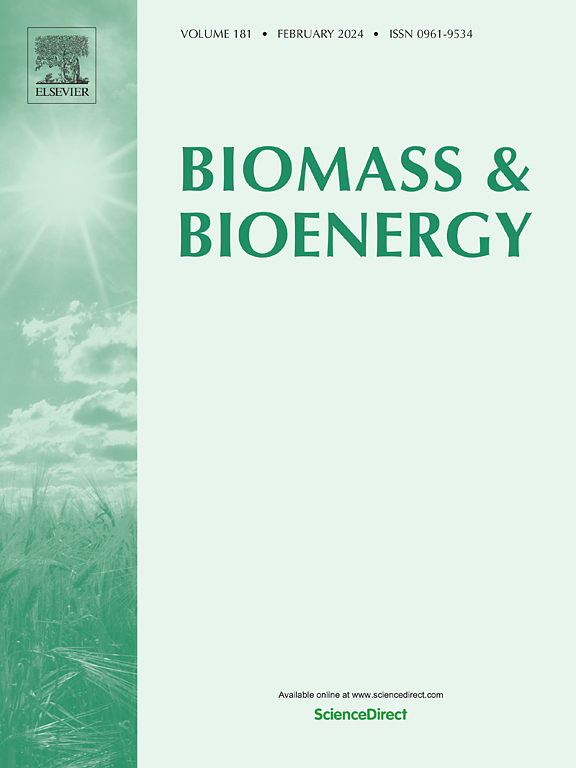三元生物质共热解产品的升级:商用和国产催化剂的调查研究
IF 5.8
2区 生物学
Q1 AGRICULTURAL ENGINEERING
引用次数: 0
摘要
催化剂在影响热解过程中的产物产量和成分方面起着关键作用,为生物质转化提供了显著优势。本研究调查了天然催化剂和商用催化剂在两种不同温度(550 ℃ 和 750 ℃)下对三元生物质协同热解的影响。在较高温度下,二次分解变得突出,导致气体产量增加,而焦炭和液体油产量减少。在两种温度条件下,引入催化剂一般都能提高木炭产量。值得注意的是,CaCO3 的生物油产率最高,而 Ca(OH)2 的生物油产率最低,气体产率的趋势正好相反。催化剂对气体成分也有影响,在 750 °C 时,Ca(OH)2 和沸石明显增加了 CH4 和 CO2 的浓度。每种催化剂类型都对气体产量和成分产生了特定的影响,凸显了催化剂和反应途径之间错综复杂的相互作用。此外,催化剂还能显著改变生物油的成分,钙基催化剂能降低酸含量,增加芳烃,而沸石在不同温度下则表现出截然不同的趋势。在生成的生物油中发现的值得注意的化合物包括双酚 A、左旋葡聚糖、苯酚和对甲酚,为塑料、生物燃料、树脂等领域提供了潜在的应用。总之,催化剂具有提高特定化合物产量、降低腐蚀性、优化生物油和焦炭成分等潜力,可用于多种工业应用,因此需要进一步研究不同催化剂的协同效应。本文章由计算机程序翻译,如有差异,请以英文原文为准。
Upgrading co-pyrolysis products from ternary biomass: An investigative study of commercial and locally-made catalysts
Catalysts play a pivotal role in influencing product yields and compositions in pyrolysis processes, offering significant advantages for biomass conversion. This study investigates the impact of natural and commercial catalysts on the co-pyrolysis of ternary biomass at two different temperatures (550 °C and 750 °C). At higher temperatures, secondary decompositions become prominent, leading to increased gas yields and decreased char and liquid oil yields. The introduction of catalysts generally enhances char yields across both temperature regimes. Notably, CaCO3 exhibits the highest bio-oil yield, while Ca(OH)2 shows the lowest, with reversed trends observed for gas yields. The influence of catalysts extends to gas composition, with Ca(OH)2 and zeolite notably increasing CH4 and CO2 concentrations at 750 °C. Each catalyst type exerts specific effects on gas production and composition, underscoring the intricate interplay between catalysts and reaction pathways. Additionally, catalysts significantly alter the composition of bio-oil, with calcium-based catalysts reducing acid content and increasing aromatics, while zeolites exhibit contrasting trends at different temperatures. Noteworthy compounds identified in the resulting bio-oil include bisphenol A, levoglucosan, phenols, and p-cresol, offering potential applications in plastics, biofuels, resins, and more. Overall, catalysts offer the potential to enhance specific compound yields, reduce corrosiveness, and optimize bio-oil and char composition for diverse industrial applications, highlighting the need for further research into synergistic effects when combining different catalysts.
求助全文
通过发布文献求助,成功后即可免费获取论文全文。
去求助
来源期刊

Biomass & Bioenergy
工程技术-能源与燃料
CiteScore
11.50
自引率
3.30%
发文量
258
审稿时长
60 days
期刊介绍:
Biomass & Bioenergy is an international journal publishing original research papers and short communications, review articles and case studies on biological resources, chemical and biological processes, and biomass products for new renewable sources of energy and materials.
The scope of the journal extends to the environmental, management and economic aspects of biomass and bioenergy.
Key areas covered by the journal:
• Biomass: sources, energy crop production processes, genetic improvements, composition. Please note that research on these biomass subjects must be linked directly to bioenergy generation.
• Biological Residues: residues/rests from agricultural production, forestry and plantations (palm, sugar etc), processing industries, and municipal sources (MSW). Papers on the use of biomass residues through innovative processes/technological novelty and/or consideration of feedstock/system sustainability (or unsustainability) are welcomed. However waste treatment processes and pollution control or mitigation which are only tangentially related to bioenergy are not in the scope of the journal, as they are more suited to publications in the environmental arena. Papers that describe conventional waste streams (ie well described in existing literature) that do not empirically address ''new'' added value from the process are not suitable for submission to the journal.
• Bioenergy Processes: fermentations, thermochemical conversions, liquid and gaseous fuels, and petrochemical substitutes
• Bioenergy Utilization: direct combustion, gasification, electricity production, chemical processes, and by-product remediation
• Biomass and the Environment: carbon cycle, the net energy efficiency of bioenergy systems, assessment of sustainability, and biodiversity issues.
 求助内容:
求助内容: 应助结果提醒方式:
应助结果提醒方式:


